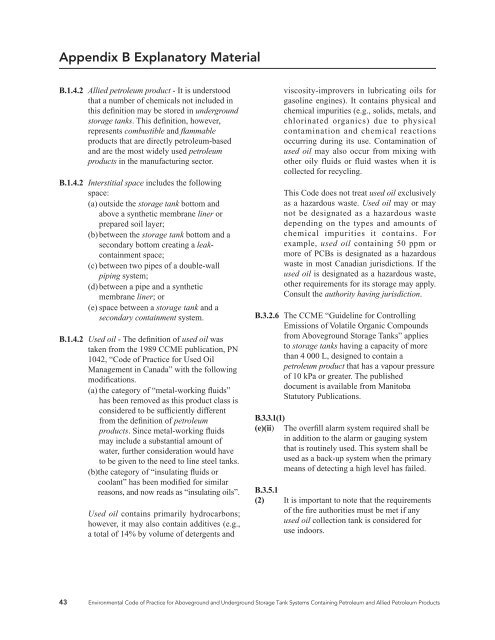Environmental Code of Practice for Aboveground and ... - CCME
Environmental Code of Practice for Aboveground and ... - CCME
Environmental Code of Practice for Aboveground and ... - CCME
Create successful ePaper yourself
Turn your PDF publications into a flip-book with our unique Google optimized e-Paper software.
Appendix B Explanatory Material<br />
B.1.4.2 Allied petroleum product - It is understood<br />
that a number <strong>of</strong> chemicals not included in<br />
this definition may be stored in underground<br />
storage tanks. This definition, however,<br />
represents combustible <strong>and</strong> flammable<br />
products that are directly petroleum-based<br />
<strong>and</strong> are the most widely used petroleum<br />
products in the manufacturing sector.<br />
B.1.4.2 Interstitial space includes the following<br />
space:<br />
(a) outside the storage tank bottom <strong>and</strong><br />
above a synthetic membrane liner or<br />
prepared soil layer;<br />
(b) between the storage tank bottom <strong>and</strong> a<br />
secondary bottom creating a leakcontainment<br />
space;<br />
(c) between two pipes <strong>of</strong> a double-wall<br />
piping system;<br />
(d) between a pipe <strong>and</strong> a synthetic<br />
membrane liner; or<br />
(e) space between a storage tank <strong>and</strong> a<br />
secondary containment system.<br />
B.1.4.2 Used oil - The definition <strong>of</strong> used oil was<br />
taken from the 1989 <strong>CCME</strong> publication, PN<br />
1042, “<strong>Code</strong> <strong>of</strong> <strong>Practice</strong> <strong>for</strong> Used Oil<br />
Management in Canada” with the following<br />
modifications.<br />
(a) the category <strong>of</strong> “metal-working fluids”<br />
has been removed as this product class is<br />
considered to be sufficiently different<br />
from the definition <strong>of</strong> petroleum<br />
products. Since metal-working fluids<br />
may include a substantial amount <strong>of</strong><br />
water, further consideration would have<br />
to be given to the need to line steel tanks.<br />
(b)the category <strong>of</strong> “insulating fluids or<br />
coolant” has been modified <strong>for</strong> similar<br />
reasons, <strong>and</strong> now reads as “insulating oils”.<br />
Used oil contains primarily hydrocarbons;<br />
however, it may also contain additives (e.g.,<br />
a total <strong>of</strong> 14% by volume <strong>of</strong> detergents <strong>and</strong><br />
viscosity-improvers in lubricating oils <strong>for</strong><br />
gasoline engines). It contains physical <strong>and</strong><br />
chemical impurities (e.g., solids, metals, <strong>and</strong><br />
chlorinated organics) due to physical<br />
contamination <strong>and</strong> chemical reactions<br />
occurring during its use. Contamination <strong>of</strong><br />
used oil may also occur from mixing with<br />
other oily fluids or fluid wastes when it is<br />
collected <strong>for</strong> recycling.<br />
This <strong>Code</strong> does not treat used oil exclusively<br />
as a hazardous waste. Used oil may or may<br />
not be designated as a hazardous waste<br />
depending on the types <strong>and</strong> amounts <strong>of</strong><br />
chemical impurities it contains. For<br />
example, used oil containing 50 ppm or<br />
more <strong>of</strong> PCBs is designated as a hazardous<br />
waste in most Canadian jurisdictions. If the<br />
used oil is designated as a hazardous waste,<br />
other requirements <strong>for</strong> its storage may apply.<br />
Consult the authority having jurisdiction.<br />
B.3.2.6 The <strong>CCME</strong> “Guideline <strong>for</strong> Controlling<br />
Emissions <strong>of</strong> Volatile Organic Compounds<br />
from <strong>Aboveground</strong> Storage Tanks” applies<br />
to storage tanks having a capacity <strong>of</strong> more<br />
than 4 000 L, designed to contain a<br />
petroleum product that has a vapour pressure<br />
<strong>of</strong> 10 kPa or greater. The published<br />
document is available from Manitoba<br />
Statutory Publications.<br />
B.3.3.1(1)<br />
(e)(ii) The overfill alarm system required shall be<br />
in addition to the alarm or gauging system<br />
that is routinely used. This system shall be<br />
used as a back-up system when the primary<br />
means <strong>of</strong> detecting a high level has failed.<br />
B.3.5.1<br />
(2) It is important to note that the requirements<br />
<strong>of</strong> the fire authorities must be met if any<br />
used oil collection tank is considered <strong>for</strong><br />
use indoors.<br />
43 <strong>Environmental</strong> <strong>Code</strong> <strong>of</strong> <strong>Practice</strong> <strong>for</strong> <strong>Aboveground</strong> <strong>and</strong> Underground Storage Tank Systems Containing Petroleum <strong>and</strong> Allied Petroleum Products

















